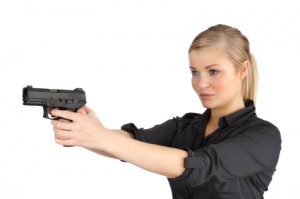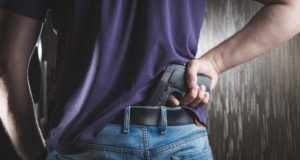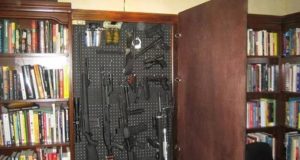Looking to the animal world, it is very obvious that the female of the species is almost always the protector of the children—her instinct kicks in and look out! The lioness and the mother bear are perfect examples. So why would we not think the same of the human race? Yes you say, a father is protective of his daughter, but a mother is protective of all her children and family.
In the animal world, the female is born with the equipment to defend—fangs, claws, and the attitude that says, “You’ve made a big mistake now!” Regretfully, in our world, a woman put in the same position is more often than not facing someone who outweighs her, outguns her, and has more upper body strength. In order to defend herself and her family, she needs to have an equalizer.
We have all seen the western movies with a pioneer mother defending her children from the Indians. The Wild West gave us the Annie Oakley’s who proved that yes, a woman could shoot as well as if not better than a man.
 Things have not changed much over the years, but thankfully the defensive weapons have. What is available to women for a defensive handgun has advanced to where there are specific “lady handguns” models, like the Lavender Lady .38 Special or the Lady Smith .38 Special—even in different colors. (Although I personally feel that a weapon should not be made into a fashion statement nor made attractive to young kids. It needs to look like what it is—mean, dangerous, and with the ability to hurt you severely.) Everyone who shoots a handgun regularly understands fit and function go together, and changing to a different grip can drastically improve accuracy.
Things have not changed much over the years, but thankfully the defensive weapons have. What is available to women for a defensive handgun has advanced to where there are specific “lady handguns” models, like the Lavender Lady .38 Special or the Lady Smith .38 Special—even in different colors. (Although I personally feel that a weapon should not be made into a fashion statement nor made attractive to young kids. It needs to look like what it is—mean, dangerous, and with the ability to hurt you severely.) Everyone who shoots a handgun regularly understands fit and function go together, and changing to a different grip can drastically improve accuracy.
The caliber of choice for a woman is dependent on how much stopping power she wants, what kind of accuracy she can achieve, and how well she can handle the handgun in a stressful situation. It used to be a standard thing for a man to buy a .38 Special for his wife to keep around the house in case the need arose. Now, the .38 is still a good defensive weapon, especial when loaded with the +P rounds, but it may not be what she needs or wants.
I remember when I first introduce my wife to handguns, and the first one she fired was my Colt 1991A1 45 Caliber Semi-Auto. She loved it! I had also bought her a .38 to keep by the bedside for emergencies. She was able to shoot a variety of handguns at the local Rod & Gun Club, from .380 to 44 Magnum in revolvers and semi-auto’s, but in the end, she choose and purchased a Kimber Compact 45 Caliber for herself. She proceeded to become proficient in the defensive pistol competitions.
The bottom line is, if a woman makes the choice of purchasing a handgun for personal defense of herself and family, it needs to be her decision on what she can safely and accurately handle. It needs to be one that she can easily put in her hands and have in a fire-ready condition, smoothly, without having to think about getting it to that condition or looking for a safety release. It should just happen. That can only be accomplished by practice. The worst scenario is waking in the night to the sound of an armed intruder in her home, grabbing a handgun from the nightstand, and trying to remember where the safety was that you showed her. The result can and will be fatal.
If you live in a state where you can obtain a concealed carry permit or a “shall issue” state and decide to carry your firearm, your choices become more involved on concealment as well as function and stopping power. Most “experts” would agree that the revolver is chosen more often because of its simplicity. As far as function, there is no safety to worry or think about, and they even come in “hammerless” models that won’t catch on clothing or items in a purse. .38 Specials with +P rounds and .357 Magnums that can be loaded with the .38 Special rounds are two of the choices. There are titanium alloy revolvers that weigh only ounces when loaded and won’t feel like a brick in your purse or holster.
The “downside” of the revolver is capacity (usually only five or six rounds) and accuracy. The accuracy of a revolver with a two-inch barrel is only a matter of feet, so stopping power is essential. Attempting to stop a 250-pound or more attacker with a .32 caliber or lower will probably just make him mad! A center mass hit from larger caliber .38 +P or .357 Magnum will stop most assailants.
For the woman that is willing to spend the time practicing and becoming confident and accurate with a larger caliber, like the .45 Caliber semi-automatic or even the 9 mm semi-automatic, you have the advantage of not only more stopping power but also capacity. The 9 mm gives you a larger capacity along with manageable kick to it, thus better accuracy. It is the choice of weapon for many law enforcement divisions as well as some branches of the military, where yes, women carry and use them too. The .45 caliber semi-auto also has the stopping power as well as added capacity in most models to remove the threat quickly and with certainty in well-trained hands.
The bottom line is that for personal self-defense, your choice of handgun should be at minimum a .38 or .357 Caliber. Either of these, as well as the 9 mm or .45 caliber, are manageable calibers for most women if they are fitted with proper grip, professional instruction, and lots of good practice. I say “good practice” because there is a big difference between just shooting at a target in the woods and shooting with a firearm instructor at a range. Learning proper grip, stance and breath control, and mental attitude are just some of the ingredients to good shot placement.
My advice is this—get good advice from a professional (lessons if possible) and try to fire as many different handguns as you can until you make your own decision on what you want between you and any possible attacker. Remember, an attacker looking down the barrel of a .22 derringer or a .357 magnum will usually be thinking two completely different thoughts. Keep in mind that the responsibility to have and potentially use a firearm in your defense rests completely on you.
©2012 Off the Grid News
 Off The Grid News Better Ideas For Off The Grid Living
Off The Grid News Better Ideas For Off The Grid Living



